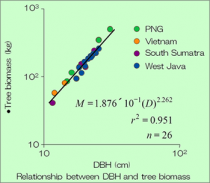Evaluating the amount of carbon storage in natural and artificial forests

- researcher's name
-
about researcher MORIKAWA, Yasushi Professor (retired)
- affiliation
- keyword
-
background
At present, amidst calls for a solution to the problem of global warming, the capacity of forests to store carbon has been recognized as a new economic asset, with efforts to assess the value gaining attention at the national and corporate levels. However, the carbon storing ability of forests differs widely with factors such as composition of species, making the development of evaluation methods a pressing challenge.
summary
Results have already been obtained in estimating the carbon storage capacity of domestic forests in Japan and tropical rain forests abroad, and a methodology has been established for simple estimation of the biomass of plantations in tropical regions. Use of this knowledge enables estimation of the carbon storage capacity of forests.
application/development
As well as estimation of the carbon storage capacity of pre-existing and artificial forests, managed by businesses and other parties, it is possible to create forests with higher capacity through the use of forest repairing technology. Furthermore, there is potential for help in research and investigation from enterprises, corporations, NGOs and other parties that want to evaluate carbon storage capacity, in the process of reforestation in developing countries.
predominance
Since there are results not only for evaluation of carbon storage capacity, but also regarding biodiversity evaluation and environmental education, comprehensive research and assessment of forests is now possible.
purpose of providing seeds
Sponsord research, Collaboration research
material
posted:
2014/05/21




